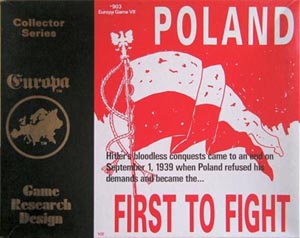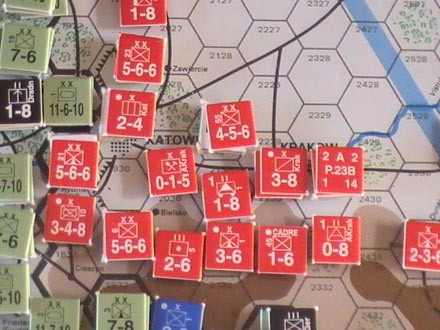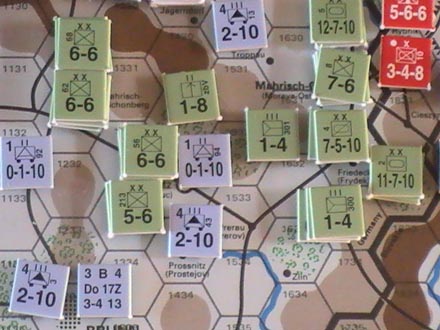

Game Mechanics
Time
Scale: Three
day turns
Map
Scale: Sixteen miles per hex
Unit Scale: Divisions, regiments, battalions
Players:
Two - Medium Complexity
Solitaire Suitability: High complexity
Playing
Time: From two to four hours, depending on the rules used - solitaire approx
12 hours
Game
components: (second
edition 1998)
1,296 Die-Cut Counters
2 Maps (one used, one for 'Grand Europa')
Rules
Book
Chart set
2 Die
Boot Camp Rules, introduced in the 1991 edition
Editions:
'Case White' (1977, 1979, 1985) 'First to Fight' (1991 & 1998)
French
Intervention
France and Britain had guaranteed Poland's independence.
Starting on game turn 4, the Polish player consults the French Intervention table
at the start of his player turn to see if France launches an offensive against
Germany. A die is rolled and the player consults the table, following modifications.
Soviet
Intervention
The Soviet Union Intervenes in Poland in the first German
player turn following the capture or the evacuation of the Polish government.
When the Soviet Union intervenes, the German player controls the Soviet forces,
which operate (move, attack, fly missions etc) during the German player turns.
Optional Rules:
a)
Advanced Game Mechanics
b) Special Unit Abilities
c) Increased Polish Capabilities
d)
German Transfers to the East
e) First Turn Airstrikes
f) Lithuania
g)
No Blitzkrieg (Polish Fantasy Option)
h) August Attack (German Fantasy Option)
i)
Defense in Depth Scenario


In
the 'First to Fight' 2nd edition (1998) one of the most significant changes are
to the air rules, with the 'air on demand' system replacing the previous edition's
air phase. A new optional rule also allows Lithuania to be added to the game.
Defense
in Depth Scenario
Perhaps something for the gamer to explore further
is the Defence in Depth Scenario. Poland had two proposed plans for its defence
against Germany in 1939. The one it adopted called for a strong defense of the
Polish border areas, with a gradual withdrawal as the German offensive developed.
The Poles hoped this plan would buy them enough time for the French to launch
an offensive and thus turn the tide against Germany.
The other plan called
for a defense in depth - Poland would abandon its overly-long border with Germany
and concentrate its troops behind the river lines of Central Poland. The Germans
would thus have to advance eastwards and then engage Polish forces ensconced in
good defensive terrain. The hope, again, was that the plan would buy enough time
for the French to enter the war and take the pressure off Poland.
The
second plan was rejected because it was too risky. The peacetime stations of many
of the Polish units were well to the west of the river lines, and these units
needed to withdraw east for the plan to work. For a variety of reasons, Poland
couldn't afford to mobilize these units and move them west, unless a German attack
was certain and imminent. This, however, led to the possibility of a German surprise
attack cathching and destroying these units as they tried to mobilize and move
east.
The Defense in Depth Scenario explores the military campaign had
Poland adopted the defense in depth plan and was able to implement it without
being caught by a German surprise attack.
|
wargames.wilkey.org.uk
|